Most cases of bloody vaginal discharge around the time of a bitch's heat cycle are no cause for concern, but what is the discharge continues for a period of time longer than expected?
So let's answer the question what is expected?
Bitches typically have a reproductive cycle that consists of 4 stages: 1:proestrus- a period of follicular recruitment and growth in the ovaries, 2:estrus- a period of time of willingness to mate with the male dog, 3:diestrus- following ovulation, the sites of follicle rupture turn into progesterone secreting structures called corpora lutea (latin for "yellow bodies") and 4: anestrus- a period where little hormonal activity is taking place following regression of the corpora lutea and preceding the next estrous cycle.
The following diagram illustrates the timing and duration of each of the phases:

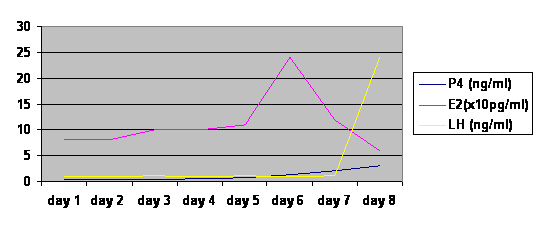
As you can clearly see from the diagram, proestrus is dominated by the presence of estrogen produced from the developing ovarian follicles. The estrogen, in addition to assisting with follicular development, is also responsible for changes to the reproductive tract and brain, that many of us are oh so familiar with. For instance, estrogen increases the vascularity to tissues in the reproductive tract and allows for extravasation of red blood cells into the lumen- seen by us a bloody vaginal discharge. Estrogen thickens the epithelial lining of the tract in preparation for breeding and increases the amount of fluid (edema) trapped in tissues like the vulva- noted as a swollen or enlarged vulva.
Estrogen also primes the brain of the bitch, increasing her receptivity towards males and willingness to stand to be mounted- interestingly enough though, bitches don't normally stand to be mounted during peak levels of estrogen. They actually mate during estrus when estrogen levels are falling off and progesterone is steadily increasing. This fact makes progesterone the hormone to use to evaluate timing of ovulation and NOT estrogen (which has already returned to baseline before ovulation). Estrogen also alters the scent of the bitch, increasing her attractiveness towards male dogs- this explains how some owners have returned home to find a "strange" dog (intact male) in their yard when their little "princess" was coming into heat.
As the bitch is approaching, estrus, progesterone levels start to increase. This useful fact allows veterinarians to monitor levels of progesterone and estimate timing of ovulation. The value of timing ovulation is immeasurable!! It can lead to more successful rate of pregnancy and increased litter sizes (more value for the breeder on their investment in semen), it can be used to estimate the day of whelping (also a time and anxiety saving feature for the breeder) and it can be used in confirmation of pregnancy loss or other pathologic conditions. One measurement can be useful, but more than one measurement over time provides the veterinarian with added information that ensures more accuracy with breeding and prediction of whelping.
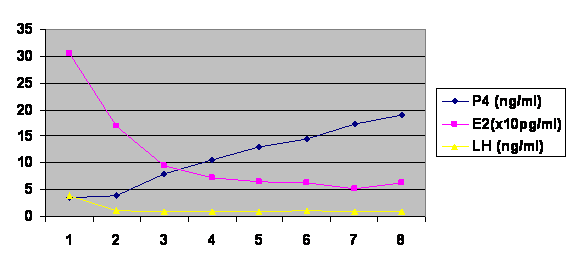
Diestrus is a phase of the estrous cycle that is dominated by progesterone. Progesterone is necessary for maintenance of a pregnancy- it keeps the uterus nice and quiet and prevents rejection of the babies by the mom's immune system. Interestingly enough though, even non-pregnant bitches have elevated progesterone levels. Why??? The theory is that this represents an atavistic (pack-related behavior) that evolved in dogs to allow subordinate bitches to cycle at the same time as the dominant breeding bitch and then lactate and nurse the alpha female's offspring while she returns to hunting. Sort of like a wet nurse for royalty.
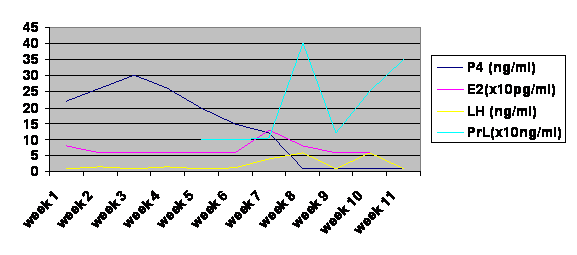
Anestrus as previously mentioned, is a relatively quiet stage of the dog's estrous cycle where not much hormonal activity is taking place until very late in this phase, just before the return to proestrus. Pregnant and non-pregnant bitches must undergo this phase for a minimum of 3 months (more typical to last 5 months) before returning back to proestrus. It allows for endometrial repair before the next cycle. Dogs are seasonally monoestrus species which simply means that they go through one complete estrous cycle including anestrus before returning back to estrus. Compare that to the cycle of the horse, a seasonally polyestrous species, that has multiple estrus periods during a defined season on increased daylight.
So if 9 days of proestrus is average and 4-8 days of estrus is average and a bloody vaginal discharge may be seen through these 2 phases, and the bitch has to complete a full (average 7 month estrous cycle) before returning back to heat, doesn't 3 months of prolonged vaginal bleeding seem unusual???
Absolutely. Is it abnormal or pathologic? Maybe not.
Bitches that are entering puberty can have certain irregularities to their estrous cycles. Expect the unexpected. Because they have never ovulated and have never had a period of diestrus (progesterone dominated), their outward signs of heat can be very mild- sometimes even silent and go missed by owners. They may also have follicles that inefficiently respond to hormonal signals designed to induce ovulation. In that case, symptoms of proestrus and estrus may be present but no ovulation occurs, and thus no period of diestrus or anestrus. Under this circumstance, vaginal bleeding may be prolonged. They may also develop very large and cystic follicles that fail to respond to both natural (internal) hormonal signals and even hormones that we give them in an attempt to force ovulation.
Other possibilities? Well, the reproductive tract and urinary tract share a common exit, so the bleeding could also come from the urinary tract e.g. bladder infection. Certain traumatic lacerations, growing masses and foreign bodies can cause bleeding. Vaginitis or endometritis/pyometra from infections like E.coli that are resistant to many antibiotics, Brucellosis acquired at breeding, or other infections like transmissible venereal tumor acquired at breeding can cause vaginal bleeding and of course, bleeding disorders like low platelet counts, von Willebrand's disease, hemophilia and exposure to rat poisons can cause bleeding from anywhere including the reproductive tract.
So we chose to check this girl's bloodwork for signs of bleeding disorders, systemic infection and urinary tract problems. The tests proved to be normal.
An ultrasound of her abdomen revealed two readily identifiable ovaries with multiple black structures corresponding to pre-ovulatory follicles and one very large follicle on one of the ovaries. See below.
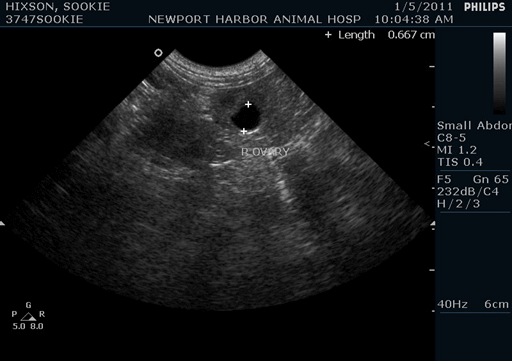
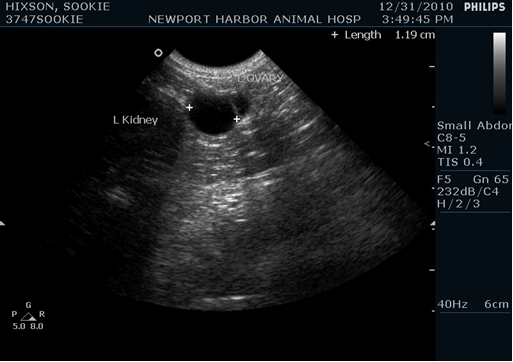
Our Pet Health Mission
Our mission at Newport Harbor Animal Hospital is: "To provide the highest quality veterinary care for our patients and the best service for our clients. Our goal in every case is a healthy pet and a happy client."
